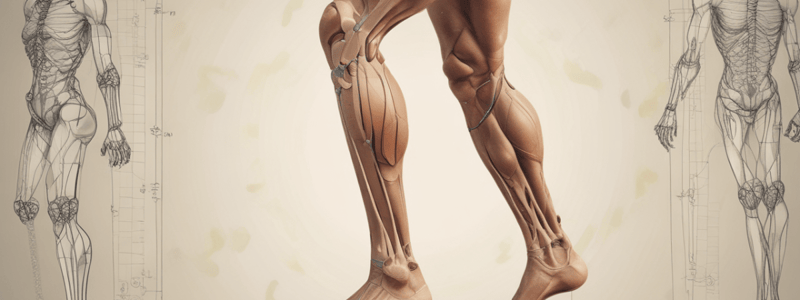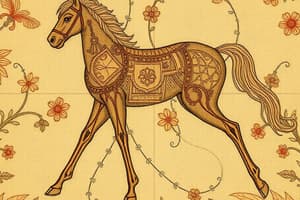Podcast
Questions and Answers
What is a cost of jerky movements?
What is a cost of jerky movements?
- Efficient energy expenditure
- High metabolic cost (correct)
- Low metabolic cost
- Slower movement velocity
What is the most reliable method for collecting client data in Clinical Gait Analysis?
What is the most reliable method for collecting client data in Clinical Gait Analysis?
- Self-administered questionnaires
- 3D motion analysis (correct)
- Visual observation
- 2D motion analysis
What happens to the force vector at mid-stance during normal gait?
What happens to the force vector at mid-stance during normal gait?
- It acts backwards and downwards
- It acts downwards with a positive horizontal force
- It acts upwards with no horizontal force (correct)
- It acts forwards with a negative horizontal force
What is a possible cause of anterior trunk bending during gait?
What is a possible cause of anterior trunk bending during gait?
What happens to the ground reaction force (GRF) during constant velocity walking?
What happens to the ground reaction force (GRF) during constant velocity walking?
What are the main differences between external and internal joint moments?
What are the main differences between external and internal joint moments?
What is the main difference between the kinetic patterns of walking and running?
What is the main difference between the kinetic patterns of walking and running?
What is the primary purpose of Clinical Gait Analysis?
What is the primary purpose of Clinical Gait Analysis?
What happens to the force vector during toe-off in normal gait?
What happens to the force vector during toe-off in normal gait?
What is the primary muscular role during the braking phase of gait?
What is the primary muscular role during the braking phase of gait?
What is the main characteristic of the deformity category of gait disorders?
What is the main characteristic of the deformity category of gait disorders?
What is the primary sign of muscle weakness in gait?
What is the primary sign of muscle weakness in gait?
What is included in observational gait analysis?
What is included in observational gait analysis?
What is the primary function of the quadriceps muscle during the early stance phase of gait?
What is the primary function of the quadriceps muscle during the early stance phase of gait?
What is the characteristic of the ground reaction force during mid-stance phase of gait?
What is the characteristic of the ground reaction force during mid-stance phase of gait?
What is the term for the upward deceleration of the center of gravity during the gait cycle?
What is the term for the upward deceleration of the center of gravity during the gait cycle?
What is the abnormal gait pattern characterized by a force vector acting in front of the knee?
What is the abnormal gait pattern characterized by a force vector acting in front of the knee?
What is the phase of gait characterized by the positive vertical force and a negative horizontal force?
What is the phase of gait characterized by the positive vertical force and a negative horizontal force?
What is the term for the horizontal force that acts in the direction of travel during toe-off?
What is the term for the horizontal force that acts in the direction of travel during toe-off?
What is the characteristic of the ground reaction force during double support phase?
What is the characteristic of the ground reaction force during double support phase?
What is the function of the quadriceps muscle in mid-stance phase?
What is the function of the quadriceps muscle in mid-stance phase?
What are the 5 categories of pathological gait?
What are the 5 categories of pathological gait?
match the stage to the action
match the stage to the action
match the stage to the action
match the stage to the action
match the stage to the action
match the stage to the action
Flashcards are hidden until you start studying
Study Notes
Gait Analysis
- A gait cycle consists of two strides, including stance and swing phases.
- In normal gait, the force vector acts slightly behind the knee in early stance phase.
Ground Reaction Forces (GRF)
Vertical Forces
- During constant velocity walking, the vertical force graph has two hill shapes of equal magnitude.
- F1: upward deceleration of the Centre of Gravity (COG) or weight acceptance (peak arrest).
- F2: COG moving over the stance limb (mid stance) or push-off rate.
- F3: upward acceleration of the COG (peak thrust) or propulsion.
Horizontal Forces (Anterior Posterior)
- The horizontal force graph has a dip and hill shape.
- F4: peak braking (arrest).
- F5: mid support (Fy = 0 BW due to change of direction).
- F6: peak propulsion (thrust).
Pathological Gait
- Deformity: affects mobility, preventing sufficient mobility to attain normal postures and Range of Motion (ROM).
- Muscle weakness: disuse muscle atrophy or neurological impairment, e.g., aging, motor neuron disorders.
- Classic signs of muscle weakness include hesitant gait initiation and jerky movements.
Clinical Gait Analysis
- Collect client data to identify gait deviations and determine causes.
- Review relevant medical data and referring notes from other health professionals.
- 3D motion analysis is the most reliable method.
Kinetics of Normal Healthy Walking
- The force vector acts slightly behind the knee in early stance phase.
- In normal gait, the force vector acts upwards and backwards during initial contact.
- At mid stance, there is a vertical force acting upwards and no horizontal force (pure vertical force).
- At toe off, there is a positive horizontal and vertical force acting upwards and forwards through the body.
Kinetic Differences between Walking and Running
- Changes in the proportion between the impact peak and active peak, with the active peak being larger in running.
- Horizontal force curve changes with a shorter start time and increased magnitude of forces.
- Running downhill increases the impact peak and decreases the active peak, while running uphill has the opposite effect.
Muscular Roles
- Swing: H3, K4, and K5 (heavy quad contribution).
- Braking: H1, K1, K2, and A1.
- Propulsion: H2, A2, and K3.
Abnormalities
- Anterior trunk bending: force vector acts in front of the knee, often due to poor quad strength.
- Posterior trunk bending: force vector acts behind the knee and hip, often due to poor hip extensor strength.
Studying That Suits You
Use AI to generate personalized quizzes and flashcards to suit your learning preferences.




